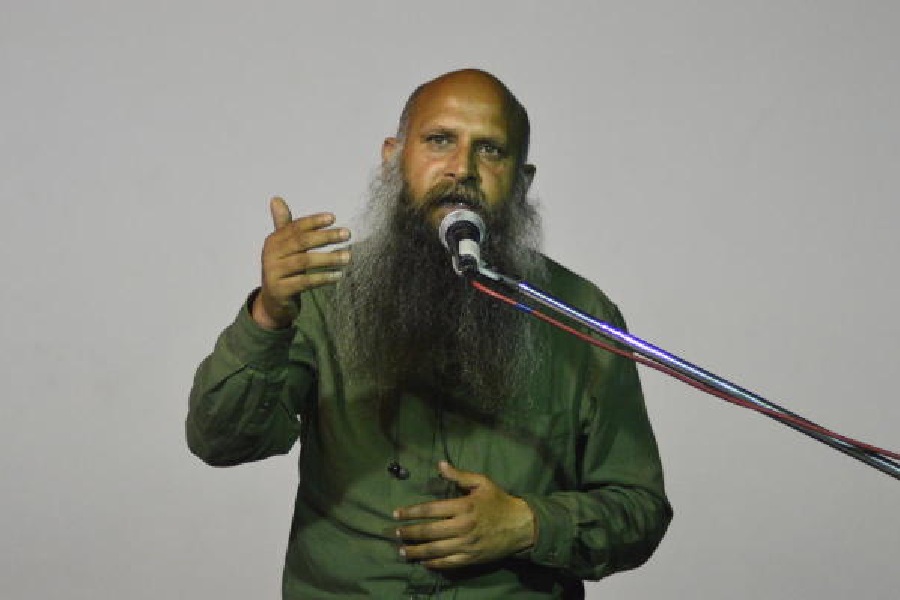The Himalayas are being crushed under the bulldozer of “vikas” (development), an activist from the subsidence-hit Joshimath, a town in Uttarakhand, told a Calcutta gathering on Sunday.
The subsidence earlier this year is the result of prioritising a “flawed” concept of development and faith, said Atul Sati, president of the Joshimath Bachao Sangharsh Samiti, which is fighting for proper rehabilitation of the residents affected by the subsidence and preservation of the fragile ecology of the Himalayas.
“The danger is not limited to Joshimath. The Himalayas are under threat. The mountains are being crushed under the bulldozer of vikas. We have been sensing danger since 2003-04. Why? Because of the hydel power projects. Heavy machinery used in the construction, the use of explosives, and deforestation, all these had led to fear. These projects are being sold as suppliers of green energy, which does not harm the environment. This is a big lie,” Sati told a packed south Calcutta auditorium.
“You build a giant tunnel and alter the natural course of a river, rerouting it through that tunnel and deeply impacting the ecosystem. Because of the blasts triggered for the construction, explosives and gunpowder get mixed in the muck. The muck is thrown in the river. It affects everything.”
Joshimath, the gateway to shrines like Badrinath and Hemkund Sahib and the popular skiing destination of Auli, appears on the edge of a precipice — it is sinking under its own weight.
In January, gaping cracks appeared on buildings, roads and public facilities in Joshimath. The government said over 850 buildings were affected.
Environmental experts and activists have attributed the crisis to heavy-duty construction for projects like the National Thermal Power Corporation’s (NTPC) Tapovan Vishnugad Hydro Project and the widening of the all-weather Char Dham road that connects Kedarnath, Badrinath, Gangotri and Yamunotri shrines.
Some researchers have also said the primary reason behind the sinking of land is the construction of a tunnel just below Joshimath. The tunnel will be used to draw water from the Alaknanda and Dhauliganga rivers for the NTPC hydropower project.
The NTPC has denied that its tunnel is passing under Joshimath. Officials of the central corporation have said the project has no role in the subsidence of the region.
Sunday’s programme was organised by the People’s Film Collective, an independent, people-funded body that screens films and hosts conversations. After his address, Sati was in conversation with Kasturi Basu, a founder of the collective.
Basu sought to know the “role of faith” in all that is happening in the mountains.
In a detailed answer, Sati said the thrust of a “homogeneous form of mainstream faith” was against the local culture as well as the true essence of pilgrimage.
The same thrust, Sati said, had put the shrines of Badrinath and Kedarnath in danger.
“Heavy-duty construction is underway for an upcoming riverfront in Badrinath. The roads still go up to Badrinath. What about Kedarnath which is not connected by a motorable road? You have to trek 16km to reach Kedarnath,” said Sati.
“Modiji has sent JCB machines on helicopters to Kedarnath. The machines are working at 12,000ft above the sea level. Hundreds of choppers are flying every day around Kedarnath. They are flying at low levels to save fuel, to maximise profits of aviation companies. Their engines do not stop,” said Sati.
This faith is being controlled by capital and profiteering, he said.
“We have an informal bond with local deities, with whom we can also engage in friendly banter. They are not like rulers but like our friends. Our faith is not built on fear and awe. It is intertwined with nature. This faith is closely linked to the conservation of the forest and the river. Now, this mainstream faith has been thrust upon us” Sati said.
The massive reduction in the time needed to reach the shrines has increased human casualties because the pilgrims do not get time to get used to the conditions 10,000ft above the sea level, he said.
“Now, you can reach Badrinath from Dehradun in one day. Three days ago, 25,000 people were jostling for space in Badrinath. There is no cap on the number of visitors. There is no regulation. All this in the name of faith. A faith that is built on just one idol.
“Earlier, the yatra did not just mean seeing the idol. It involved getting familiar with the river, glacier, plants, everything. The pilgrimage meant an immersive experience inseparable from the local environment. This frenzy to somehow reach the temple and touch the idol is destroying the ecology.”
Sati’s conversation with Basu was followed by the screening of an Oscar-nominated documentary, Moti Bagh. The award-winning 2019 film by Nirmal Chander highlights the multilayered crisis in Uttarakhand, which is fraught with thousands of “ghost villages” caused by mass migration to cities.
The film depicts the struggle to save farming, the socio-economic rift with Nepali agricultural labourers, all amid increasing incidents of forest fires and earthquakes in a very fragile Himalayan ecology.
